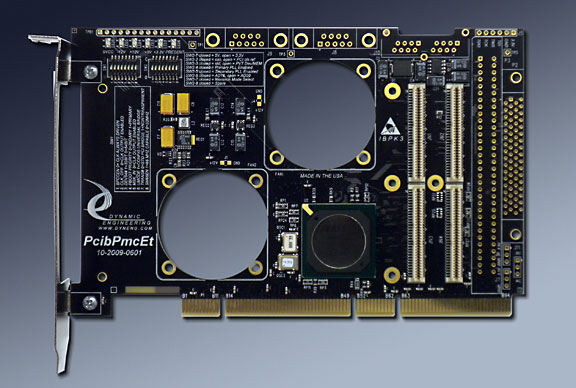| Size |
Half size PCI card.
|
| |
|
| PMC compatible slot |
1 PMC Slot provided.
|
| |
|
| Clocks |
PCI primary bus can operate at 66 or 33 MHz.
Secondary side can operate at 66 or 33 MHz.
|
| |
|
| Access Width |
Standard PCI byte lanes supported for byte, word and long access dependent on installed PMC. 64 or 32 bit operation from either bus supported by Bridge.
|
| |
|
| Access Frequency |
Bridge supports 66 or 33 MHz operation.
|
| |
|
| Software Interface |
The bridge does not require any user set-up. PMC register definitions as defined by installed hardware. Bridge configuration space can be used to modify bridge settings for special situations. |
|
|
| Interrupts |
INTA, INTB, INTC, INTD routed to PCI connector. Most PMC´s use one Interrupt level [INTA].
|
| |
|
| Power |
+5, +12, -12V, +3V, 3.3VAUX, VIO supplied to PMC. +5 and 3.3V have full planes with 1 oz CU. VIO has partial plane with 2 oz CU. +/- 12V have mini planes with multi-amp current capacity, Full 2 oz ground plane.
|
| |
|
| VIO |
Primary side set by PCI bus. Secondary side set by user selection.
|
| |
|
| Thermal |
PCIBPMCET has a pair of cut-outs to support increased airflow over the PMC component side. Optional fans are available with no increase in PCI slot count ‹ multiple PCIBPMCET can be used with fans in adjacent PCI slots.
|
| |
|
| IO Interface |
Front Bezel IO supported at PCI bracket. Jn4 user IO supported with either SCSI or DIN connectors. See Panduit for mate [120-964-455] or standard SCSI II connector. Optional support for Ethernet and Serial ports from PrPMC devices.
|
|
| |
|
Specification |
PICMG 2.15 specification compliant for Ethernet and Serial Port options.
|
| |
|
| |
|
| LED´s |
+3V, +5V, +12V, -12V and Busmode 1 [present]. |
| |
|
| DIP switch |
Two 8 position switches provided to control Bridge settings and other selections [VIO on secondary side etc.] |
| |
|
| JTAG |
The PMC JTAG connections are tied to a labeled header. Add -JTAG to your order to have this header installed. |
| |
|
| MTBF |
1.27 Million hours per Bellcore SR-332 GB 25C (estimated) |
| Speed |
With the PCIBPMCET design, the backplane PCI bus can operate at 33 or 66 MHz and with 32 or 64 bit data paths while the PMC has the same options isolated by the bridge. Depending on the configuration, the bridge may reduce latency when a 32/33 PMC is used in a 64/66 system since the bridge can buffer the accesses and do the conversion locally. For same size transfers there will be an added delay passing through the bridge for target read and write operations. Interrupts bypass the bridges in the system to provide no added delay in that path.
|
| |
|
| Price |
PCIBPMCET is a quality board at a reasonable price. The overall system cost can be reduced by making use of existing PMC designs in PCI applications without paying for the expense of a new design and layout. Quantity discounts are available. When your quantity grows to the point where a native PCI or other configuration is warranted please contact Dynamic Engineering to see about a flattened design to eliminate the carrier and perhaps other boards in your system.
|
| |
|
| Ease of Use |
PCIBPMCET is easy to use. A plug and play interface to the PMC site. The Bridge can be configured with the user switches on board; eliminating any requirement for special software for the bridge itself. The board comes configured for a 66 MHz capable primary bus and 33 MHz secondary bus. In most cases the switches can be left with the factory settings. The switches are clearly labeled on the fab. The manual also contains clear directions for use.
|
| |
|
| Availability |
PCIBPMCET is part of a popular family of components. Dynamic Engineering does frequent manufacturing runs of our carriers in an effort to keep them in stock and ready for our clients. Send in your order, and in most cases have your hardware the next day. For larger orders consider scheduling to capture larger discounts and have more control over future delivery.
|
| |
|
| Size |
PCIBPMCET is a half size PCI board which conforms to the PCI mechanical and electrical specifications. Eliminate mechanical interference issues. PCIBPMCET can be used in all PCI slots including the new narrow chassis. Even with fans installed PCIBPMCET can be installed into adjacent PCI slots.
|
| |
|
| PMC Compatibility |
PCIBPMCET is PMC compliant per the IEEE 1386 specification. All Dynamic Engineering PMC Modules are compatible with the PCIBPMCET. All other PMC Modules which are compliant with the PMC specification are compatible with the PCIBPMCET. |
| |
|
| PCI Compatibility |
PCIBPMCET is PCI compliant. PCIBPMCET can be expected to work in any PCI compliant backplane. PCIBPMCET has been tested in multiple backplanes. |
























